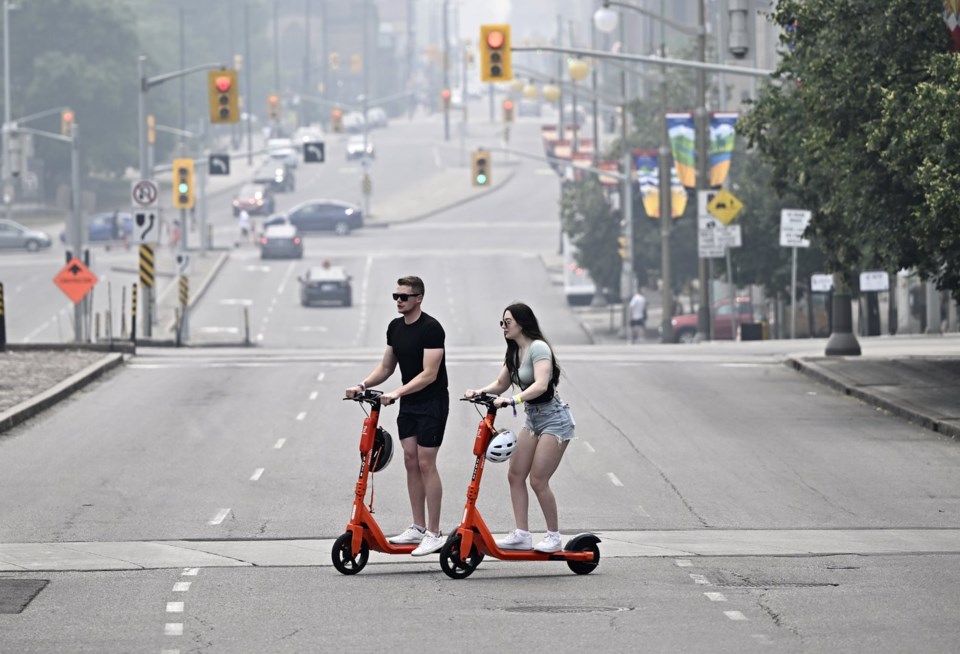TORONTO — The Canadian Institute for Health Information says e-scooter injuries are on the rise across the country.
"We thought it was really important to shed light on this important topic, given that regulations really vary across the jurisdictions," said Tanya Khan, manager of CIHI's hospital data advancement and engagement team.
There was a 32 per cent increase in e-scooter hospitalizations in Canada over a one-year period, the data said, rising from 375 in 2022-2023 to 498 in 2023-2024, she said.
The data, released Thursday, said hospitalizations involving e-scooters for kids between five and 17 years old increased by 61 per cent — from 33 to 53 — in that time period.
CIHI said hospitalizations for men between 18 and 64 went up by 22 per cent over that year, from 267 to 325.
The increase was even more striking for women, with a 60 per cent rise from 114 hospitalizations to 182.
The data shows the majority of e-scooter hospitalizations happened in Ontario, Quebec, Alberta and British Columbia.
Dr. Daniel Rosenfield, a pediatric emergency physician at SickKids Hospital in Toronto, said the number of kids and teens arriving in the emergency department with e-scooter injuries has been increasing over the last five years and some have been "catastrophic," including one 13-year-old boy's death in 2023.
"We see anything from minor scrapes and cuts and little lacerations that need a couple of stitches to ... traumatic brain injury, internal bleeding in the chest and abdomen, open fractures that need to go to the operating room to be fixed," he said.
Some children between four and six years old have been hurt while riding with their parents on an e-scooter, Rosenfield said, but injuries among teens riding on their own is more common.
Among cases where the information is available, 80 per cent of the riders who end up in the ER aren't wearing helmets, he said.
Rosenfield said he thinks the rise in injuries correlates to an increase in the popularity and affordability of e-scooters in recent years — together with a lack of understanding about how dangerous they can be.
"These scooters, much like everything electrified these days, have come down in price and have increased in power," he said.
"Their acceleration and torque is tremendous. And most parents, when they're buying these things for their kids, are completely unaware of that."
Kids get hurt when they fall off their e-scooters, Rosenfield said, but the most severe injuries happen when they hit a car or truck or a vehicle hits them.
Pamela Fuselli, president and CEO of Parachute Canada — a charity focused on injury prevention — said the laws around e-scooters vary between provinces and even municipalities.
In Ontario, riders must be at least 16 years old. But in Toronto, e-scooters are not allowed on public roads or paths. Just east of the city in Oshawa, they're permitted under a pilot program.
E-scooters are often available to rent — the city of Vancouver's website, for instance, promotes e-scooters as "an accessible and sustainable way to move around and explore Vancouver." Riders must be 16 and older and cannot go over 25 km/hour.
People are clearly using e-scooters everywhere whether they're allowed or not, Fuselli said.
"Even while a city may have a bylaw about this, they can regulate what's operated in public spaces, but then that has to be enforced. They can't really regulate what's sold."
Fuselli said kids under 16 should not be riding e-scooters — and parents shouldn't be buying them for children younger than that.
"They look like toys, but they really are motor vehicles," she said.
Rosenfield said although kids can also be injured riding non-electric push scooters, including broken bones and head injuries if they're not wearing a helmet, "you're comparing apples and oranges" when it comes to safety.
"The speed that a little kid can get (on a push scooter) is at most five to 10 kilometres an hour," he said, noting his emergency department doesn't tend to see the "catastrophic injuries" that they see with e-scooters.
This report by The Canadian Press was first published July 17, 2025.
Canadian Press health coverage receives support through a partnership with the Canadian Medical Association. CP is solely responsible for this content.
Nicole Ireland, The Canadian Press



